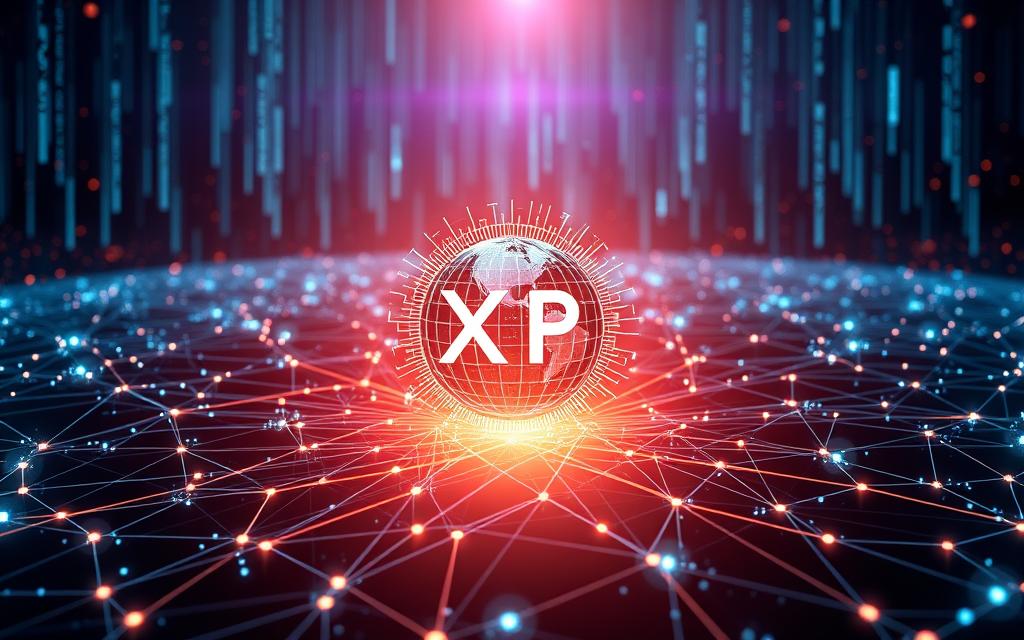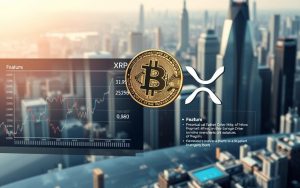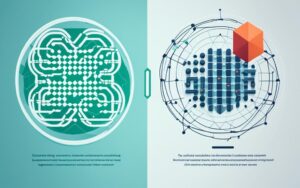Table of Contents
The XRP Ledger (XRPL) stands as a pioneering decentralized blockchain, built for speed, efficiency, and real-world utility. For over a decade, this open-source network has enabled seamless transactions, serving businesses and developers worldwide.
Unlike traditional systems, the XRPL operates without centralized control. A global community of engineers, validators, and enterprises maintains its robust infrastructure. This collaborative approach ensures reliability, with over 63 million ledgers processed error-free.
Designed for enterprise adoption, the ledger supports cross-border payments, asset tokenization, and scalable solutions. Its energy-efficient consensus mechanism sets it apart, offering a sustainable alternative to proof-of-work blockchains. Discover how the XRP Ledger is shaping the future of decentralized finance.
Introduction to XRPL and XRP
Global financial transactions find a fast, reliable solution with XRP. This digital currency powers the XRP Ledger, enabling near-instant transfers at minimal cost. Unlike volatile assets, it’s designed for real-world utility, bridging currencies and payment systems.
Understanding XRP’s Role
XRP acts as the native asset on its ledger, with all 100 billion tokens created at launch. A small fraction is burned per transaction, creating a deflationary model. This ensures predictability for businesses and users alike.
Key functions include:
- Paying transaction fees (fractions of a cent)
- Facilitating liquidity in payment corridors
- Settling cross-border transfers in 3-5 seconds
XRP vs. Ripple: Clearing the Confusion
While Ripple, the company, utilizes XRP in its RippleNet system, the cryptocurrency operates independently. The ledger’s decentralized nature means no single entity controls it—not even Ripple.
| Feature | XRP | Traditional Banking |
|---|---|---|
| Settlement Time | 3-5 seconds | 1-5 business days |
| Cost per Transaction | $0.0002 | $25-$50 (wire transfers) |
| Energy Use | Negligible | High (data centers) |
To hold XRP, users need a compatible wallet, such as Ledger or XUMM. These tools provide secure storage and easy access to the network.
How the XRP Ledger Works
Speed and efficiency define the XRP Ledger’s operational framework. This decentralized blockchain relies on a global network of independent validators to process transactions in seconds. Unlike centralized systems, no single entity controls the ledger.

Decentralized Public Blockchain
Over 150 validators maintain the network, with Ripple operating just one node. This distributed setup ensures resilience against outages or manipulation. Each validator follows the same consensus protocol, voting on transaction validity.
The process unfolds in three steps:
- Initiation: A user submits a transaction (e.g., payment, token trade).
- Validation: Servers cross-check details against the latest ledger version.
- Settlement: Consensus is reached, and the transaction finalizes in 3-5 seconds.
Key Features of the XRP Ledger
Built for enterprise use, the ledger offers unmatched throughput and low costs. A base fee of 0.00001 XRP deters spam, with fees burned to reduce supply. This model supports 1,500+ transactions per second—outpacing Visa’s average capacity.
| Feature | XRPL | Traditional Finance |
|---|---|---|
| Settlement Time | 3-5 seconds | 1-3 days |
| Cost per Transaction | $0.000002 | $25+ (wire transfers) |
| Throughput | 1,500+ TPS | 50-100 TPS (SWIFT) |
Developers leverage built-in tools like escrow and payment channels for complex workflows. The on-ledger decentralized exchange (DEX) enables trustless trading of high-growth digital assets. Smart contract support via Codius further expands use cases.
The Consensus Mechanism of XRPL
Efficiency meets decentralization in the XRP Ledger’s consensus mechanism. Unlike proof-of-work blockchains, this system skips energy-intensive mining. Instead, trusted validators collaborate to confirm transactions in seconds.
How Validators Achieve Consensus
The ledger uses a multi-round voting process. Validators cross-check transactions against the latest ledger version. For approval, 80% must agree—a supermajority that prevents forks.
Key steps include:
- Proposal: Nodes submit candidate transactions.
- Validation: Servers verify details against network rules.
- Settlement: Consensus finalizes in under 5 seconds.
Unique Node List Explained
The Unique Node List (UNL) acts as a trust anchor. Each participant selects reputable validators, creating a decentralized web of nodes. The default UNL includes 35+ high-performance servers.
Dynamic adjustments ensure fault tolerance. Poor performers are replaced, maintaining network reliability. This curated approach balances decentralization with efficiency.
| Feature | XRPL Consensus | Bitcoin (PoW) |
|---|---|---|
| Energy Use per Transaction | 0.0079 kWh | 1,173 kWh |
| Validator Participation | 150+ nodes | ~1M miners |
| Carbon Neutral | Yes (offsets) | No |
Ripple’s decentralization roadmap aims to expand the UNL further. This growth reinforces the ledger’s resilience without compromising speed.
Validators and Network Security
A diverse group powers the XRP Ledger’s backbone—independent validators ensuring seamless operations. These nodes, run by universities, financial institutions, and developers, form a decentralized web of trust. Ripple operates just one of the 35+ default Unique Node List (UNL) servers, reinforcing the ledger’s neutrality.

Who Runs Validators?
The community drives validator participation. Top-tier universities like MIT and Kyoto University host nodes, alongside exchanges such as Bitso and Bithumb. Individual developers also contribute, creating a balanced network free from centralized control.
Incentives include:
- Enhanced security: Operators gain direct oversight of transaction integrity.
- Reputation building: High-performance nodes earn trust and influence.
- Ecosystem growth: Participation fosters innovation in decentralized finance.
Role of Validators in Transaction Approval
Each transaction undergoes rigorous checks. Validators cross-reference details against the latest ledger version, ensuring compliance with network rules. Consensus requires 80% agreement, preventing forks and malicious activity.
Key safeguards include:
- Geographic diversity: Nodes span 20+ countries, reducing single-point failures.
- Real-time validity checks: Suspicious transactions are flagged instantly.
- Reputation scoring: Poor performers are replaced automatically.
Redundancy measures, like duplicate servers, ensure uptime. Malicious actors face immediate removal from the UNL, preserving the ledger’s integrity.
Sustainability of the XRP Ledger
Environmental responsibility is built into the core of the XRP Ledger’s architecture. This blockchain redefines efficiency, using 120,000x less energy than proof-of-work networks like Bitcoin. Its carbon-neutral status, achieved through offsets since 2020, aligns with global sustainability goals.

Energy Efficiency Compared to Proof of Work
The ledger’s consensus mechanism eliminates energy-intensive mining. Validators work collaboratively, consuming just 0.0079 kWh per transaction—equivalent to powering a lightbulb for 30 minutes. In contrast, Bitcoin’s proof-of-work model wastes 1,173 kWh per transaction.
Key advantages include:
- Low hardware demands: Validators operate on standard servers, avoiding costly mining rigs.
- Scalable infrastructure: 1,500+ transactions per second with minimal energy use.
- Redundant design: Geographic node distribution prevents energy-intensive outages.
| Metric | XRPL | Bitcoin (PoW) |
|---|---|---|
| Energy per Transaction | 0.0079 kWh | 1,173 kWh |
| Annual Carbon Footprint | 0 tons (offset) | ~37M tons |
| Hardware Lifespan | 5-7 years | 1-2 years (ASIC miners) |
Carbon Neutrality and Long-Term Viability
Ripple’s partnership with carbon offset programs ensures the ledger’s net-zero impact. Renewable energy powers 40% of validator nodes, with plans to reach 100% by 2030. This process supports corporate ESG mandates, attracting institutional investment.
The community-driven roadmap prioritizes:
- Expanding solar/wind-powered node operations.
- Reducing transaction finality time to under 3 seconds.
- Maintaining sub-cent fees to preserve value for users.
By combining energy efficiency with proactive offsets, the XRP Ledger offers a sustainable way forward for decentralized finance.
Practical Uses of XRPL
From remittances to digital collectibles, the ledger powers diverse applications. Financial institutions and developers harness its speed for solutions spanning micropayments to central bank digital currencies (CBDCs). Over 50% of validator nodes now support enterprise-grade implementations.

Fast and Low-Cost Transactions
Cross-border payments settle in 3 seconds at 1/1000th the cost of wire transfers. Major remittance corridors like US-Mexico show 60% savings versus traditional methods. Liquidity pools enable instant currency exchange without intermediaries.
Micropayment solutions unlock new models:
- Content creators earn $0.001 per article view
- IoT devices pay for data transfers autonomously
- Gaming assets trade peer-to-peer with sub-cent fees
Business and Developer Applications
Over 300 projects build on the ledger, from NFT marketplaces to corporate treasuries. The XRPL Grants program funds 50+ teams annually, accelerating development of DeFi tools and CBDC prototypes.
Key enterprise adoptions include:
| Sector | Use Case | Savings |
|---|---|---|
| Banking | Real-time correspondent banking | 40-70% |
| Gaming | In-game asset tokenization | 90% fewer fraud cases |
| Media | Royalty distribution | Instant global payouts |
Trust Wallet and other platforms simplify asset management with integrated XRPL support. Step-by-step guides help businesses migrate from legacy systems to blockchain-based workflows.
Conclusion
Innovation thrives on the XRP Ledger, blending speed with sustainability. This network delivers 3-second finality for transactions, offering a practical way to modernize finance. Enterprises save 60%+ on cross-border payments while reducing carbon footprints.
The growing community drives adoption, with key metrics standing out:
- 1,500+ TPS throughput outperforms legacy systems
- $0.000002 average cost per transaction
- 300+ projects building DeFi and CBDC solutions
As institutional investment rises, this blockchain sets the standard for scalable, eco-friendly infrastructure. Explore developer grants or set up a secure wallet to join the evolution.
FAQ
How does the XRP Ledger differ from traditional blockchains?
Unlike Bitcoin or Ethereum, the XRP Ledger uses a consensus protocol instead of proof-of-work. This makes transactions faster, cheaper, and more energy-efficient while maintaining decentralization.
What role do validators play in the XRPL network?
Validators secure the network by verifying transactions and maintaining the ledger. They rely on a Unique Node List (UNL) to achieve agreement without mining, ensuring trust and efficiency.
Why is XRPL considered sustainable?
The ledger’s consensus mechanism consumes minimal energy compared to proof-of-work systems. Ripple, the company behind XRP, has also committed to carbon neutrality, enhancing long-term viability.
Can businesses use XRPL for payments?
Yes. The network processes transactions in 3-5 seconds with negligible fees, making it ideal for cross-border payments, remittances, and enterprise solutions.
How does the XRP Ledger handle transaction fees?
Each transaction burns a tiny amount of XRP (around
FAQ
How does the XRP Ledger differ from traditional blockchains?
Unlike Bitcoin or Ethereum, the XRP Ledger uses a consensus protocol instead of proof-of-work. This makes transactions faster, cheaper, and more energy-efficient while maintaining decentralization.
What role do validators play in the XRPL network?
Validators secure the network by verifying transactions and maintaining the ledger. They rely on a Unique Node List (UNL) to achieve agreement without mining, ensuring trust and efficiency.
Why is XRPL considered sustainable?
The ledger’s consensus mechanism consumes minimal energy compared to proof-of-work systems. Ripple, the company behind XRP, has also committed to carbon neutrality, enhancing long-term viability.
Can businesses use XRPL for payments?
Yes. The network processes transactions in 3-5 seconds with negligible fees, making it ideal for cross-border payments, remittances, and enterprise solutions.
How does the XRP Ledger handle transaction fees?
Each transaction burns a tiny amount of XRP (around $0.0002) to prevent spam. This fee structure discourages misuse while keeping costs low for users.
Who controls the XRP Ledger?
No single entity controls it. The network is decentralized, with validators operated by universities, exchanges, and community members worldwide.
What makes XRPL suitable for developers?
Its open-source nature, low latency, and support for tokens, smart contracts (via Hooks), and DeFi applications provide a flexible foundation for innovation.
Is XRP the same as the XRP Ledger?
No. XRP is the native cryptocurrency, while the XRPL is the decentralized blockchain that facilitates its transactions and other functionalities.
.0002) to prevent spam. This fee structure discourages misuse while keeping costs low for users.
Who controls the XRP Ledger?
No single entity controls it. The network is decentralized, with validators operated by universities, exchanges, and community members worldwide.
What makes XRPL suitable for developers?
Its open-source nature, low latency, and support for tokens, smart contracts (via Hooks), and DeFi applications provide a flexible foundation for innovation.
Is XRP the same as the XRP Ledger?
No. XRP is the native cryptocurrency, while the XRPL is the decentralized blockchain that facilitates its transactions and other functionalities.









